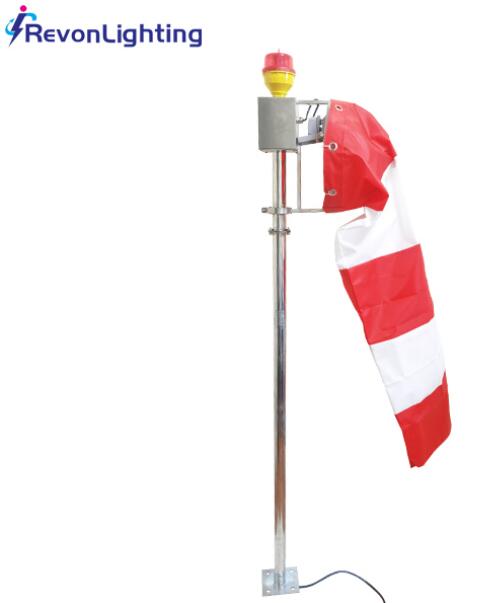In the world of aviation, safety and precision are paramount. Every component of an airport's infrastructure plays a vital role in ensuring smooth and secure operations, and the windcone and wind cone airport are no exceptions. These seemingly simple devices provide critical information to pilots, aiding in safe landings and takeoffs. This article explores the significance, design, and benefits of windcones, with a particular focus on their application in airports.
Windcone: A Fundamental Aviation Tool
A windcone, also known as a windsock, is a device used to show the direction and strength of the wind. It is a simple yet highly effective tool that has been a staple in aviation for decades. Typically made of a conical textile tube, the windcone is mounted on a pole and rotates freely with the wind. The larger end catches the wind, causing the cone to align with the wind direction and indicate its speed based on how far it is extended.
The primary purpose of a windcone is to provide real-time wind information to pilots. Wind direction and speed are crucial factors in aviation, influencing everything from takeoff and landing procedures to in-flight maneuvering. By observing the windcone, pilots can make informed decisions about how to approach the runway, which direction to take off, and how to adjust their flight path for optimal safety and performance.
Wind Cone Airport: Enhancing Operational Safety
At airports, wind cones are strategically placed to ensure they are visible from various vantage points. The term "wind cone airport" refers to the specific placement and usage of windcones within an airport setting. These devices are often located near runways, taxiways, and helipads to provide critical wind information to pilots at crucial stages of their operations.
The placement of wind cones at airports is not arbitrary. They are positioned to give pilots a clear view as they approach for landing or prepare for takeoff. Airports typically use multiple windcones to cover different areas, ensuring comprehensive wind monitoring across the entire facility. In addition to being placed at the ground level, some wind cones are elevated on towers to be visible above obstacles and provide a better indication of upper-level wind conditions.

Design and Functionality
The design of a windcone is simple but effective. Made from durable, weather-resistant materials, the cone is designed to withstand various environmental conditions. The conical shape allows it to capture the wind efficiently, and its lightweight construction ensures it responds quickly to changes in wind direction and speed.
Wind cones are often painted in bright, contrasting colors, such as orange and white, to enhance visibility. Some wind cones are illuminated for nighttime operations, using internal or external lights to ensure they can be seen in low-light conditions. This feature is particularly important at busy airports that operate around the clock.
Benefits of Windcones
Real-Time Wind Information: The primary benefit of windcones is their ability to provide real-time wind information. This data is critical for pilots, helping them make informed decisions about their approach, landing, and takeoff.
Enhanced Safety: By providing accurate wind direction and speed information, windcones enhance the overall safety of aviation operations. Pilots can adjust their techniques based on current conditions, reducing the risk of accidents and improving flight performance.
Cost-Effective and Low Maintenance: Windcones are relatively inexpensive to install and maintain. Their simple design means they require minimal upkeep, making them a cost-effective solution for airports of all sizes.
| Wind Cone Airport | indcone |
| 23 | DFT |
Versatility: Windcones can be used in various settings, from small private airstrips to large international airports. Their versatility makes them an essential tool across the entire aviation industry.
Technological Advancements
While the basic design of the windcone has remained largely unchanged, technological advancements have led to some enhancements. Modern windcones may include sensors that provide electronic wind data to air traffic control and pilot displays. These sensors can measure wind speed and direction with high precision, offering additional data to complement the visual indication provided by the windcone.
Some advanced windcones are integrated with automated weather observation systems (AWOS) and other airport monitoring systems. This integration allows for real-time data collection and analysis, improving the overall efficiency and safety of airport operations.
Challenges and Considerations
Despite their simplicity and effectiveness, windcones are not without challenges. Their accuracy can be affected by surrounding obstacles, such as buildings or trees, which can create turbulence and disrupt wind patterns. Therefore, careful consideration must be given to their placement to ensure they provide accurate and reliable information.
Weather conditions can also impact the performance of windcones. Heavy rain, snow, or ice can weigh down the cone, reducing its sensitivity to wind changes. Regular maintenance and inspection are necessary to ensure windcones remain functional and accurate.
The windcone and wind cone airport are indispensable tools in the aviation industry. Their ability to provide real-time wind information enhances the safety and efficiency of flight operations, aiding pilots in making informed decisions. While simple in design, windcones are highly effective and have remained a critical component of airport infrastructure for decades. As technology continues to advance, we can expect further improvements in their functionality, ensuring they remain a vital part of aviation safety for years to come.